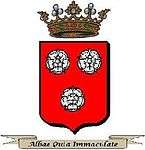Saboulin Bollena

The "de Saboulin Bollena" (or Sebolin, or Sabolin) is a french nobility family[1] of Provence[2]
This family was sentenced for nobility fraud in 1667 but accepted as member of the nobility in 1668.[3] One of his member was knighted by a office of secretary of the king at the great chancellery in 1704.
They lived until 1620 in Var[4] in the cities of Brignoles and Signes where several generations served as Captain General.[5] Furthermore, Francois de Saboulin Bollena, lord of La Motte-du-Caire, first Consul of the city of Hyères,[6] was a deputy sent from the States of Provence to the Estates-General of the kingdom held at Paris in 1614.[7]
They next settled in Marseille, where Pierre de Saboulin Bollena was an ealdorman[8] and distinguished himself by the help he gave to the charities for the Holy Land and for the restoration of the Holy Sepulchre Church in Jerusalem,[9] and Francois de Saboulin Bollena, first ealdorman and Mayor,[10] secretary to the King, House and Crown of France.[11]
They intermarried with the families of Beausset, d'Ortigues, Glandevès, d'Amalric, Pontevès-Maubousquet, Valavoire, Clapiers-Collongues, Robineau de Beaulieu, d'Adaoust, Tressemanes-Simiane, Félix de La Ferratière, Guerrier de Dumast.
They participated in the growth of the shipping industry[12] in Marseille through trade with the ports of the Levant - Chios,[13] Constantinople,[14] Sidon[15] - but also with Tetouan,[16] Morocco. They were the first shipowners to organize maritime trade between Marseilles and the West Indies.[17] The present-day Museum of the Old Marseille one of the oldest houses in the city called the "Maison Diamantée" was the mansion-house of the Saboulin Bollena.[18] Armand de Saboulin Bollena served in the French Navy and was injured during the American Revolutionary War at the Siege of Savannah.
A branch of the Saboulin family remained in Bayonne,[19] during the 17th[20] and 18th[21] centuries, from which came several generations of corsairs,[22] one of them Michel de Saboulin migrated to Martinique at the end of the 18th century. Jean de Saboulin was a deputy representing the nobility at the General Assembly of the State of the Basque Country in 1789.[23]
Since the second part of the 18th century the family was settled in Aix-en-Provence,[24] where the oldest branch lived in the castle of Lanfant near Luynes.[25] Other branches lived in Barjac, Lozère at the castle of La Vigne,[26] and in Vannes, Brittany.
References
- ↑ Régis Valette, Catalogue de la noblesse française contemporaine, Éditions Robert Laffont, Paris, 1977
- ↑ Louis Ventre d'Artefeuil, Histoire héroïque et universelle de la noblesse de Provence, volume 2, p. 352, and volume 3 (supplement) pp. 307-309, 1776
- ↑ E.de Séréville, F. de Saint-Simon, Dictionary of the french nobility, 1975, page 891.
- ↑ Abbé Dominique Robert de Briançon, L'État de la Provence, vol. 3, Paris 1693
- ↑ Abbé V. Saglietto, La Commune de Signes (Étude archéologique et historique, 1935)
- ↑ Duval & Lalourcé, Recueil de pièces originales et authentiques concernant la tenue des états-généraux, vol. 5, Paris 1789
- ↑ Augustin Thierry, The Formation and Progress of the Tiers État, or Third Estate in France vol. 2 [1856], APPENDIX II: LISTS OF THE DEPUTIES OF THE TIERS ÉTAT TO THE STATES-GENERAL OF 1484, 1560, 1576, 1588, 1593, AND 1614
- ↑ Paul Masson, Les Bouches-du-Rhône : encyclopédie départementale, 1932
- ↑ Henri Ternaux-Compans, Lettre écrite de Jérusalem le 11 juin 1698 au sujet du rétablissement de l'église du Saint Sépulcre, accordée aux religieux de Saint François sur la demande de l'Ambassadeur du Roy à la Cour Ottomane - extracted from Mercure galant, October 1698, in "Archives des voyages ou Collection d'anciennes relations inédites ou très-rares de lettres, mémoires, itinéraires et autres documents relatifs à la géographie et aux voyages, suivies d'analyses d'anciens voyages et d'anecdotes relatives aux voyageurs", 1840, p. 207
- ↑ Revue de Marseille et de Provence, volume 16, Marseilles, 1870, p. 6
- ↑ Abraham Tessereau, Histoire chronologique de la grande Chancellerie de France, vol. 2, Paris 1706
- ↑ Gabriel-Joseph Lavergne-Guilleragues, Correspondance, 1976
- ↑ Philip Pandely Argenti, Diplomatic archive of Chios, 1577-1841, volume 1, University Press, 1954
- ↑ Edhem Eldem, French trade in Istanbul in the eighteenth century, 1999
- ↑ Maurice H. Chéhab, Documents diplomatiques et consulaires relatifs à l'histoire du Liban et des pays du Proche-Orient du XVIIe siècle à nos jours, volume 1, no. 2, éditions des œuvres politiques et historiques, 1975
- ↑ Henri Marie de La Croix Chastries (comte de), Les sources inédites de l'histoire du Maroc de 1530 à 1845, vols. 1 & 4, E. Leroux, 1931
- ↑ Charles Carrière, Négociants marseillais au XVIIIe siècle : contribution to l'étude des économies maritimes, volume 1, Institut historique de Provence, 1973 p. 68
- ↑ La Maison Diamantée ou l'Oustau Bigarrado pouncho de diamant
- ↑ Mercure de France, novembre 1746
- ↑ Société des sciences, lettres & arts de Bayonne, bulletin numéros 114 à 119, p. 460/461
- ↑ Recueil de documents relatifs à la convocation des États Généraux de 1789, bailliage de Labourd
- ↑ Édouard Ducéré, Histoire maritime de Bayonne : les corsaires sous l'Ancien Régime, 1895
- ↑ Louis de la Rocque et Édouard de Barthélemy, Catalogue des gentilshommes en 1789, 1866
- ↑ René Borricand, Les Hôtels particuliers d'Aix-en-Provence, 1971
- ↑ Antoine C. Sfeir, Le Domaine de Lanfant, mémoire sous la direction du professeur Éric Mension-Rigau, université Paris-1 Panthéon-Sorbonne 2009. (extrait tiré de)
- ↑ http://www.francedusud.com/languedoc-roussillon/lozere/vallee-du-lot/barjac.html